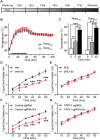Activation of temperature-sensitive TRPV1-like receptors in ARC POMC neurons reduces food intake
- PMID: 29689050
- PMCID: PMC5915833
- DOI: 10.1371/journal.pbio.2004399
Activation of temperature-sensitive TRPV1-like receptors in ARC POMC neurons reduces food intake
Abstract
Proopiomelanocortin (POMC) neurons in the arcuate nucleus of the hypothalamus (ARC) respond to numerous hormonal and neural signals, resulting in changes in food intake. Here, we demonstrate that ARC POMC neurons express capsaicin-sensitive transient receptor potential vanilloid 1 receptor (TRPV1)-like receptors. To show expression of TRPV1-like receptors in ARC POMC neurons, we use single-cell reverse transcription-polymerase chain reaction (RT-PCR), immunohistochemistry, electrophysiology, TRPV1 knock-out (KO), and TRPV1-Cre knock-in mice. A small elevation of temperature in the physiological range is enough to depolarize ARC POMC neurons. This depolarization is blocked by the TRPV1 receptor antagonist and by Trpv1 gene knockdown. Capsaicin-induced activation reduces food intake that is abolished by a melanocortin receptor antagonist. To selectively stimulate TRPV1-like receptor-expressing ARC POMC neurons in the ARC, we generate an adeno-associated virus serotype 5 (AAV5) carrying a Cre-dependent channelrhodopsin-2 (ChR2)-enhanced yellow fluorescent protein (eYFP) expression cassette under the control of the two neuronal POMC enhancers (nPEs). Optogenetic stimulation of TRPV1-like receptor-expressing POMC neurons decreases food intake. Hypothalamic temperature is rapidly elevated and reaches to approximately 39 °C during treadmill running. This elevation is associated with a reduction in food intake. Knockdown of the Trpv1 gene exclusively in ARC POMC neurons blocks the feeding inhibition produced by increased hypothalamic temperature. Taken together, our findings identify a melanocortinergic circuit that links acute elevations in hypothalamic temperature with acute reductions in food intake.
Conflict of interest statement
The authors have declared that no competing interests exist.
Figures






Similar articles
-
Activation of the ARCPOMC→MeA Projection Reduces Food Intake.Front Neural Circuits. 2020 Nov 5;14:595783. doi: 10.3389/fncir.2020.595783. eCollection 2020. Front Neural Circuits. 2020. PMID: 33250721 Free PMC article.
-
Cholinergic neurons in the dorsomedial hypothalamus regulate food intake.Mol Metab. 2017 Jan 12;6(3):306-312. doi: 10.1016/j.molmet.2017.01.001. eCollection 2017 Mar. Mol Metab. 2017. PMID: 28271037 Free PMC article.
-
Optogenetic Stimulation of Arcuate Nucleus Kiss1 Neurons Reveals a Steroid-Dependent Glutamatergic Input to POMC and AgRP Neurons in Male Mice.Mol Endocrinol. 2016 Jun;30(6):630-44. doi: 10.1210/me.2016-1026. Epub 2016 Apr 19. Mol Endocrinol. 2016. PMID: 27093227 Free PMC article.
-
Food intake in early life and epigenetic modifications of pro-opiomelanocortin expression in arcuate nucleus.Mol Biol Rep. 2021 Apr;48(4):3773-3784. doi: 10.1007/s11033-021-06340-x. Epub 2021 Apr 20. Mol Biol Rep. 2021. PMID: 33877530 Review.
-
The hypothalamic arcuate nucleus and the control of peripheral substrates.Best Pract Res Clin Endocrinol Metab. 2014 Oct;28(5):725-37. doi: 10.1016/j.beem.2014.03.003. Epub 2014 Apr 4. Best Pract Res Clin Endocrinol Metab. 2014. PMID: 25256767 Review.
Cited by
-
A journey from molecule to physiology and in silico tools for drug discovery targeting the transient receptor potential vanilloid type 1 (TRPV1) channel.Front Pharmacol. 2024 Jan 24;14:1251061. doi: 10.3389/fphar.2023.1251061. eCollection 2023. Front Pharmacol. 2024. PMID: 38328578 Free PMC article. Review.
-
Interaction between TRPV1-expressing neurons in the hypothalamus.J Neurophysiol. 2019 Jan 1;121(1):140-151. doi: 10.1152/jn.00004.2018. Epub 2018 Nov 21. J Neurophysiol. 2019. PMID: 30461371 Free PMC article.
-
Intersections in Neuropsychiatric and Metabolic Disorders: Possible Role of TRPA1 Channels.Front Endocrinol (Lausanne). 2021 Nov 29;12:771575. doi: 10.3389/fendo.2021.771575. eCollection 2021. Front Endocrinol (Lausanne). 2021. PMID: 34912298 Free PMC article. Review.
-
Effect of 8-Methyl Nonanoic Acid, a Degradation By-Product of Dihydrocapsaicin, on Energy and Glucose Homeostasis in Diet-Induced Obese Mice.J Exp Pharmacol. 2025 Aug 13;17:555-570. doi: 10.2147/JEP.S536185. eCollection 2025. J Exp Pharmacol. 2025. PMID: 40827132 Free PMC article.
-
Advanced neurobiological tools to interrogate metabolism.Nat Rev Endocrinol. 2023 Nov;19(11):639-654. doi: 10.1038/s41574-023-00885-6. Epub 2023 Sep 6. Nat Rev Endocrinol. 2023. PMID: 37674015 Review.
References
-
- Baker FC, Waner JI, Vieira EF, Taylor SR, Driver HS, Mitchell D. Sleep and 24 hour body temperatures: a comparison in young men, naturally cycling women and women taking hormonal contraceptives. J Physiol. 2001;530(Pt 3):565–74. doi: 10.1111/j.1469-7793.2001.0565k.x . - DOI - PMC - PubMed
-
- Schlader ZJ, Stannard SR, Mundel T. Human thermoregulatory behavior during rest and exercise—a prospective review. Physiol Behav. 2010;99(3):269–75. doi: 10.1016/j.physbeh.2009.12.003 . - DOI - PubMed
-
- Hibi M, Oishi S, Matsushita M, Yoneshiro T, Yamaguchi T, Usui C, et al. Brown adipose tissue is involved in diet-induced thermogenesis and whole-body fat utilization in healthy humans. Int J Obes (Lond). 2016;40(11):1655–61. doi: 10.1038/ijo.2016.124 Katsuragi are employees of the Kao Corporation. The other authors have no personal or financial conflicts of interest. - DOI - PMC - PubMed
-
- Caterina MJ, Schumacher MA, Tominaga M, Rosen TA, Levine JD, Julius D. The capsaicin receptor: a heat-activated ion channel in the pain pathway. Nature. 1997;389(6653):816–24. doi: 10.1038/39807 . - DOI - PubMed
-
- Smith GD, Gunthorpe MJ, Kelsell RE, Hayes PD, Reilly P, Facer P, et al. TRPV3 is a temperature-sensitive vanilloid receptor-like protein. Nature. 2002;418(6894):186–90. doi: 10.1038/nature00894 . - DOI - PubMed
Publication types
MeSH terms
Substances
Grants and funding
LinkOut - more resources
Full Text Sources
Other Literature Sources
Molecular Biology Databases
Research Materials
Miscellaneous

